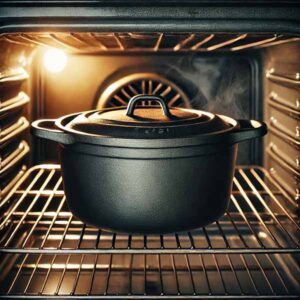
In part one, we went over the basics of cast iron cookware and why they would be the homesteads ultimate cooking tool for the future. Hopefully with our list of virtues over conventional cookware you decided to take the plunge and invest in your own “heavy metal”. Ok so you went out and got yourself some new virgin cast iron. Sure, your first inclination is to go out and start cooking, what could go wrong the pan said pre-seasoned. Most likely if this was your first experience with cast iron cookware you probably had a terrible time, and things stuck. That’s because the factory seasoning is just the basic minimum and requires some extra work to perfect it.
What the heck is Seasoning?
Seasoning cast iron is the process of creating a natural, non-stick coating on the surface of the cookware by polymerizing oil. Polymerizing is simply cross-linking a whole bunch of monomers (single molecole) making them attach themselves to each other chemically to form polymers. By using oils and grease combined with high heat the oils form a hard layer on the cast iron like an M&M shell. The more you use and season your cookware the more layers build up making a non-stick surface. This is the reason a new cast iron skillet is a dull metal black, where a well-seasoned pan will have a rich smoother black surface.
Here’s how to season cast iron and what makes it non-stick:
Seasoning Cast Iron:
Clean the Cookware: Start by washing the cast iron cookware with hot water and a brush to remove any debris. Avoid using soap, as it can strip away the factory seasoning. Note use soap if you need to remove old seasoning to start fresh for any reason.
Dry Thoroughly: Dry the cookware completely with a towel to prevent rusting. You can also heat it on the stovetop or in the oven to ensure it’s completely dry.
Apply Oil: Apply a thin layer of oil (such as vegetable oil, flaxseed oil, or grapeseed oil) to the entire surface of the cookware, including the handle and exterior. Remember you want to wipe off the excess oil, we are looking for a thin coat only.
Bake: Place the oiled cookware upside down in a preheated oven (usually around 375-400°F) and bake for about an hour. This process polymerizes the oil, creating a durable seasoning layer. Warning you probably will have some smoke. *Tip* Place a cookie sheet below the pan to catch the dripping oil.
Repeat: You may need to repeat the seasoning process several times to build up a strong, non-stick coating on the cookware. Each layer will darken the color of the pan, so you know you are on the right track.
Non-Stick Properties:
The non-stick properties of seasoned cast iron come from the polymerization of oil on the surface of the cookware. When the oil is heated in the oven, it forms a protective layer that fills in the pores of the cast iron, creating a smooth and non-stick surface.
This seasoning layer prevents food from sticking to the cookware, making it easier to cook delicate foods like eggs, pancakes, and fish without them sticking. The more you use and maintain your seasoned cast iron cookware, the better the non-stick properties become.
Regularly seasoning your cast iron cookware and using proper cooking techniques can help maintain its non-stick properties and ensure that your food cooks evenly and releases easily from the surface.
The XDMAN’s way to season:
The above season procedure is the recommended factory way of seasoning cast iron and while not wrong is a waste in my opinion. You need to season a brand-new pan multiple times for several hours, which is such a waste of resources. Instead, my preferred way is to use the pan to cook some tasty bacon. Yep, the natural seasoning way knocking two birds out with one stone. Using the bacon as it cooks releases oil which you can then use to coat the pan and as the pan heats up you start the seasoning process. After the bacon is cooked, dump out the excess grease use a paper towel to spread the oil all over the pan and let it heat up some more. Turn up the temperature just till the oil starts to smoke. And let it smoke for a while. How about next using the cookware to fry some chicken or pork chops? A couple meals later and you have your seasoning off to a good start. A good test of the seasoning will be when you can fry an egg with light oil or butter without it sticking to the pan. If it sticks, scramble them eggs and continue cooking more bacon or frying things in the pan.
Cleaning and maintenance
Now that we have our seasoning, Cleaning and maintaining cast iron cookware is essential to preserve its seasoning and prolong its lifespan.
Cleaning:
Cool Down: Allow the cast iron cookware to cool slightly before cleaning to avoid warping or cracking.
Hand Wash: Use hot water and a stiff brush or non-abrasive scrubber to clean the cookware. Avoid using soap, as it can strip away the seasoning.
Dry Thoroughly: After washing and rinsing with hot water, dry the cookware immediately and thoroughly with a towel to prevent rusting. You can also heat the cookware on the stovetop or in the oven to ensure it’s completely dry.
Re-season if Necessary: If the cookware has lost its seasoning or shows signs of rust, re-season it by applying a thin layer of oil and heating it in the oven.
Long Term Maintenance:
Season Regularly: To maintain the non-stick surface of your cast iron cookware, season it regularly with oil. You can do this by applying a thin layer of oil and heating it in the oven. I try to do this after every cook. After cleaning and drying using a paper towel I apply the lightest coat of oil just to shine it up. Then on the stove to raise the temperature enough for a couple minutes to get the pan and oil to slightly smoke. Turn off the heat and let it be.
Avoid Harsh Chemicals: Avoid using harsh detergents, metal scouring pads, or abrasive cleaners that can damage the seasoning. Stick to hot water and a brush for cleaning. I like to use salt and a paper towel on the pans cooking surface to scour stuck food for a good cleaning.
Store Properly: Store your cast iron cookware in a dry place to prevent moisture build-up and rust. You can stack pans with paper towels in between to absorb excess moisture.
Use Proper Utensils: Avoid using metal utensils that can scratch the surface of the cookware. Opt for wooden, silicone, or nylon utensils instead. Even though this is the factory recommended advice, I opt for metal utensils making sure that I am careful when using not gouging into the pans surface.
Abuse: Avoid extreme temperature changes, such as placing a hot pan in cold water, as this can cause cracking or warping. Before cleaning or rinsing let the cookware lower in temperature and try to use the hottest water you can. The hotter the water the easier it is to dry.
By following these cleaning and maintenance tips, you can keep your cast iron cookware in good condition, ensure its longevity, and continue to enjoy cooking with it for years to come.
With proper care and maintenance, cast iron cookware can last for generations and even improve with age. Sure, this article may scare some away with all the warning and rules that you should follow. But it’s not different from modern cookware. With a Copper or Teflon coated pan you should not use metal utensils the same as cast iron, although cast iron can be repaired with use! The use of harsh chemicals can damage modern cookware coatings and quickly moving them from too cold can also warp the lighter modern pans as well. Basically, at the end of the day the rules are the same, keep them clean, dry and they are happy. So enough with all the rules. In part three of the “Cast Iron Chronicles”, we’ll move on to actually using them!
James the “XDMAN” Nicholas
